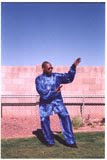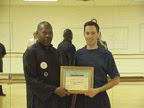It is my first Post of 2012 and I hope your New Year is off to a good start. There is so much drama going on in the world that it can be difficult not to get caught in the funnel and drawn into the madness. It can be equally difficult to keep the world’s drama from intruding itself into your life. The conditions of the world can serve to move you towards your Path in life or they can influence you to take roads that are not meant for you to travel. That is why we study the Traditional Martial and Healing Arts. We practice the philosophy of Wu-Te promoted during the 6th Century A.D. by the Buddhist Monk and Patriarch of the Shaolin Temple Tradition, Bodhidharma (Ta Mo). Wu-Te (Martial Virtue, Martial Discipline) means that we practice the Traditional Martial and Healing Arts in order to achieve physical, mental, spiritual, and social well-being. One of the most important parts of our training is the practice of Qigong. What we today call Qigong was first introduced to the Shaolin by Ta-Mo as a system of breathing exercises based on the ancient Pranayama (breathing techniques and disciplines) exercises of his homeland, India.
Each school semester Seifu Andrew and I switch between teaching the Kung Fu Class or the Qigong Class. This semester it is my turn to teach Qigong. Since my Posts focused on Lesson Plans 1 and 2 least year, I thought we spend the next few months sharing some wisdom to help you with your Qigong training and development. Qi (chi) is a Chinese term meaning air, breath, life force, or vital energy. It is energy in a quantum state, a basic component of all levels of the Cosmos, including the life force that circulates within and animates the human body and all living things. In other words, Qi is not just some metaphysical idea. Qi is part of the objective reality.
When I was a pre-teen and teenager, I use to fall asleep with my arm suspended in the air as though it was lying on an invisible cushion. It was only later that I realized that what I was experiencing was the objective reality of Qi and its place in the Quantum Field. When Grand Master Alan Lee taught me the 8 Silk Weaving Qigong Exercises I immediately fell in love with the system and the experience of feeling the Qi. Many of you have already had this experience and are ready for more. Some of you may be studying Qigong for the first time and have that experience to look forward to in the near future. Qigong practice does not always entail using a formal system of movements, postures, or breathing. You can practice your Qigong for a few minutes at work, school, home, or in a nearby park. Sitting or standing in a good posture, clearing your mind by focusing on your breathing, and regulating your breathing are all that are required to engage the Qi and call its presence and power into your awareness and experience.
It is never good to restrict students in their pursuit of knowledge for such pursuit is based on an inner drive tied to ones Destiny. To block someone from his or her Destiny will result in the creation of negative energy. Reading books on Qigong can be very helpful when a teacher is not available and even to supplement what you are getting from your teacher. In my case, I was fortunate enough to study directly under a master, to travel to China and demonstrate my own Qigong discipline in the presence of masters. And of course, I returned from China with several books on Qigong. I’ve read them all! I subsequently traveled to Southeast Asia and Indonesia furthering my knowledge of the ancient and varied traditions of what I sometimes call body-mind energy manipulation exercises. The name is too long to be useful except in stating that when we speak of Qigong we are talking about the Chinese version of something that is quite widespread in the traditions of indigenous cultures around the world. The Chinese have raised that practice to a profound level of excellence and offered it to the world. Today there are Qigong students, practitioners, teachers, and masters of various nationalities and faiths on virtually every continent. Most of them would not consider themselves to be martial artists. They are doctors, lawyers, school teachers, students, professors, soldiers, business people, dancers, actors, musicians, and public servants. Hopefully, you are and will continue to be one of them.
What I have compiled in Unlocking The Healing Powers In Your Hands: The 18 Mudra System of Qigong is based on the knowledge and experience of my past four decades dancing with the Qi. I’m biased of course but nonetheless let me suggest that if you haven’t read this book it would give you a good foundation for internalizing the things we will be talking about in my next few Posts. There is an exercise in the beginning of the book on the Ho-Me-So Breath and Feeling the Qi. Buy it and try it!
What is Qigong?
Chi Kung (Qi gong, Qigong) is a comprehensive system of body movements and breathing exercises aimed at stimulating, potentiating, and manipulating the life force or vital energy. These techniques strengthen the immune system, tone the muscles, add flexibility to the joints, repairs and revitalizes body tissue, increases energy and stamina, and produces a deep level of relaxation and calm.
Live Wu-Te
Seifu Sharif
Saturday, January 28, 2012
Subscribe to:
Posts (Atom)


